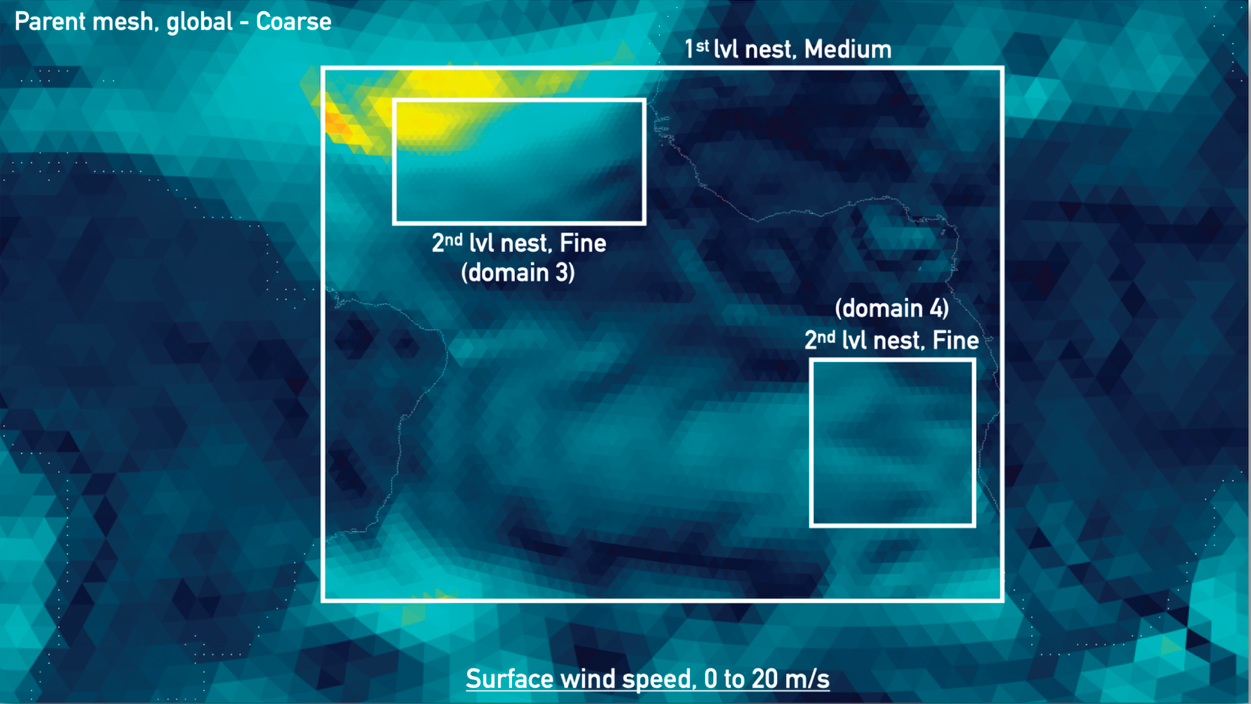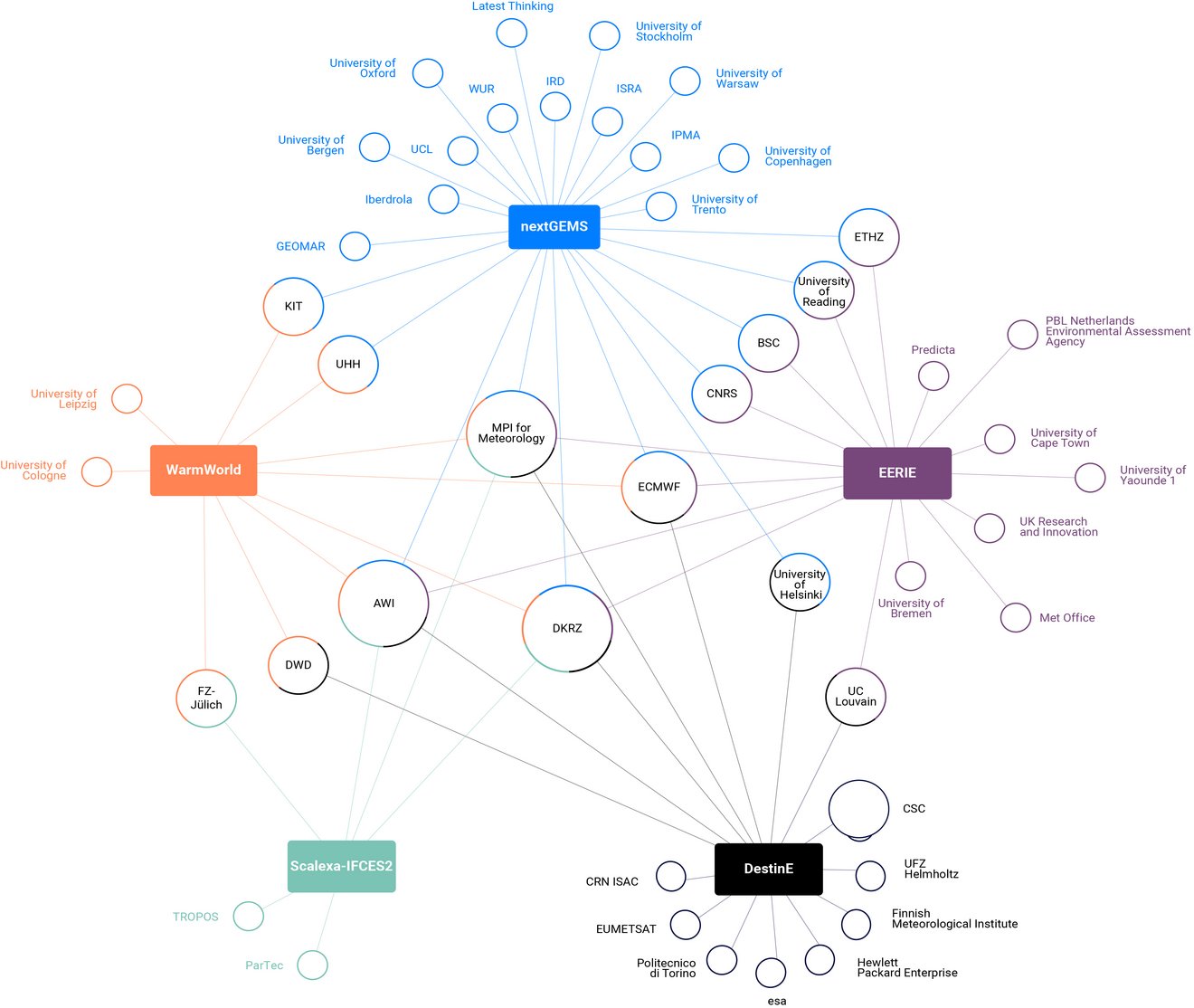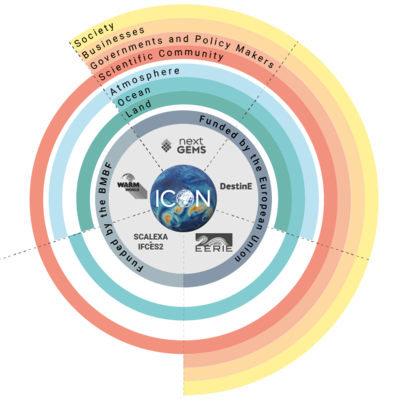A new generation of models for kilometer-scale climate projections
Global temperatures have already risen more than one degree above pre-industrial levels, with a further increase expected. While this main trend and its links to human activities have been unequivocally established, there is a considerable uncertainty in how this will affect communities and eco-systems at the regional and local level. The increased frequency of destructive weather events, such as precipitation extremes, extended droughts, and heatwaves are expected corollaries to warming. Yet, projecting the probability and intensity of these events at the local scale cannot be done with confidence.
Observations during the last decades reveal changes in the Earth system that traditional modelling approaches cannot explain, exposing a deficiency in capturing the relevant processes. A new generation of models includes physics at smaller spatial scales that traditional approaches leave out, potentially enabling us to understand the already detected and a probably growing catalog of changes. To reinvest the global climate with some of its local meaning, and render its impacts tractable to regional decision-makers, a new paradigm of high-resolution models seeks to approach the globally local nature of climate change. What unites these projects is the vision of a future where informed decision-making and proactive measures can mitigate the impacts of a rapidly changing climate on the one hand, and better inform interventions on the other hand — both globally and locally. In such a future, climate science would:
- bring local granularity to climate information globally, allowing for well-informed decision making and sustainable development;
- uncover the new physics needed to resolve the growing conundrum of yet unexplained changes following the warming global climate;
- perform simulations on the scale of observations, allowing to exploit and valorize investments in observational science;
- invigorate theory through an explicit representation of processes that are not presently being simulated.
The Max Planck Institute for Meteorology (MPI-M) is currently investing its capabilities in several projects building towards high-resolution climate projections:

nextGEMS
Next Generation Earth System Models (nextGEMS), a project funded by the European Union in the Horizon 2020 framework, is dedicated to developing storm-resolving Earth system models. The goal is to operate the ICON (Icosahedral Non‐hydrostatic) and IFS (Integrated Forecast System) models at a horizontal grid resolution of down to 2.5 km – a dramatic improvement over current models, which typically use a 100-150 km scale. By achieving this unprecedented resolution in stable climate runs, nextGEMS will provide more accurate and realistic representations of the climate system at global and regional scales for the next 30 years, providing a clearer view on phenomena such as atmospheric storms, ocean eddies, and ice dynamics. At the end of March 2024, during the Hamburg hackathon, the first 30-year high-resolution climate projections with a spatial resolution of less than 10 kilometers were completed.
WarmWorld
A prominent issue decision-makers around the world are facing regarding the implementation of regional climate policy is the uncertainty associated with climate impacts on small scales. The project WarmWorld, funded by the Federal Ministry of Education and Research (BMBF), engages the manifold challenges of a heating planet by advancing the high resolution capabilities of our Earth System Model ICON, thereby contributing significantly to the ongoing developments. WarmWorld aims to increase ICON’s run time efficiency, construct a more fine-meshed model grid, and overall seeks to create a more seamless experience of end-users. Four sub projects are trying to make ICON Better, Faster, Easier, and Smarter. Respectively, these are concerned with a more realistic approximation of physical processes; the creation of a more agile and modularized software stack; the design of effective workflows to optimally harness and utilize information-rich climate data; and with engaging the applied mathematics and informatics communities in building efficient workflows and improving model run performance.

DestinE
Imagine there were a digital version of the Earth that would provide answers to questions we might have about its future. Developing such a digital twin (DT) is the aim of the EU initiative Destination Earth (DestinE). Led by the European Centre for Medium-Range Weather Forecasts (ECMWF) in collaboration with the European Space Agency (ESA) and the European Organization for the Exploitation of Meteorological Satellites (EUMETSAT), DestinE brings together decades of advancements in weather prediction, Earth observations, high-performance computing and climate science. The project focuses on two primary DTs: the Weather-Induced Extremes DT to enhance disaster preparedness and response, and the Climate Change Adaptation DT, operationally offering detailed projections for policymakers. The goal is to have those DTs available by 2030.
A central component of DestinE is the Digital Twin Engine, which provides the computational infrastructure required to run these advanced models. This engine integrates high-performance computing and sophisticated modeling techniques to ensure simulations are accurate, scalable, and capable of processing vast amounts of data.
EERIE
With a particular focus on the ocean, European Eddie-rich Earth-System Models (EERIE) are developed to capture the dynamics of certain turbulent flow patterns, so-called ocean eddies. These small-scale currents significantly influence global and especially regional climate patterns. By improving the spatial resolution of these models, EERIE will enhance the accuracy of climate predictions and deepen our understanding of ocean-atmosphere interactions extending to the centennial time-scales.
SCALEXA
The objective of the BMBF call for SCALEXA projects is to accelerate “New methods and technologies for exascale high-performance computing”. The whole array of high-performance computing, artificial intelligence and data analytics requires improved code and workflow scalability. This also applies to Earth System Modelling. Within SCALEXA, the MPI-M contributes to the IFCES2 (“Intra-model Functional Concurrency towards efficient Exascale Earth System prediction”) and the ExaOcean ("Improving the performance of the ICON-O ocean model on heterogeneous exascale supercomputers with machine learning methods") projects, which both work with components of the ICON model. New methods are developed within the projects to, respectively, optimize the parallel execution of simulation algorithms on heterogeneous and modular exascale systems (i.e., the most powerful supercomputers), and to pursue a novel combination of "classical" algorithms of numerical mathematics with machine learning. The developments of IFCES2 will be validated with use cases from cloud microphysics and ocean biogeochemistry, while ExaOcean will make ICON-O ready for exascale systems.
Diverse approaches, a common goal
While each project brings its unique focus and methodology to the forefront, their collective actions form a comprehensive effort of advancing climate science. nextGEMS as one of the first projects in this class serves as a proof-of-concept. WarmWorld is building on the prototyping done in nextGEMS by advancing code structure and model capabilities of the ICON model in a systematic way. The aim of SCALEXA-IFCES2 is to develop methods for executing the code of these advanced models on new exascale systems. EERIE supplements the advancements of nextGEMS with enhanced accuracy in the simulation of ocean eddies to longer timescales. And the goal of DestinE’s DTs is to work towards an operationalization of these climate simulations.

The interconnections between the different projects are not only conceptual, but also practical: The nextGEMS hackathons serve as a good testing ground for the developments in WarmWorld, EERIE and SCALEXA by testing essential features that are proving to be crucial for data management and analysis, as well as user experience.
The collaborative endeavors strive to represent processes in ways that are similar to how they are observed, giving new saliency to observations, valorizing enormous investments in operational science (e.g., the EarthCARE satellite). Through such an increasingly more physical representation of the climate system, the new generation of climate models revive theory: Rather than requiring theory to explain what the models currently leave out, they ask theory to explain the net effects of what they include.
As a welcome bonus of the joint overarching goal of developing the next generation of climate information systems, these projects also manage to bridge the gaps between communities of researchers, creating stronger links between atmospheric scientists, oceanographers, computational scientists, computer engineers, mathematicians, social scientists and science communicators. By harnessing innovative methodologies and fostering interdisciplinary collaboration, these projects pave the way for a deeper understanding of the Earth system, better more salient climate prediction, impact assessment and adaptation strategies.
More information
- nextGEMS
- Destination Earth (DestinE)
- EERIE
- WarmWorld
Contacts at MPI-M
nextGEMS and WarmWorld
Dr. Heike Konow
Dr. Elina Plesca
nextgems_office@mpimet.mpg.de
warmworld_office@mpimet.mpg.de
ICON / DestinE
Dr. Daniel Klocke
daniel.klocke@mpimet.mpg.de
EERIE
Prof. Dr. Jin-Song von Storch
jin-song.von.storch@mpimet.mpg.de
SCALEXA-IFCES2
Dr. Fatemeh Chegini
fatemeh.chegini@mpimet.mpg.de
SCALEXA-ExaOcean
Dr. Peter Korn
peter.korn@mpimet.mpg.de

